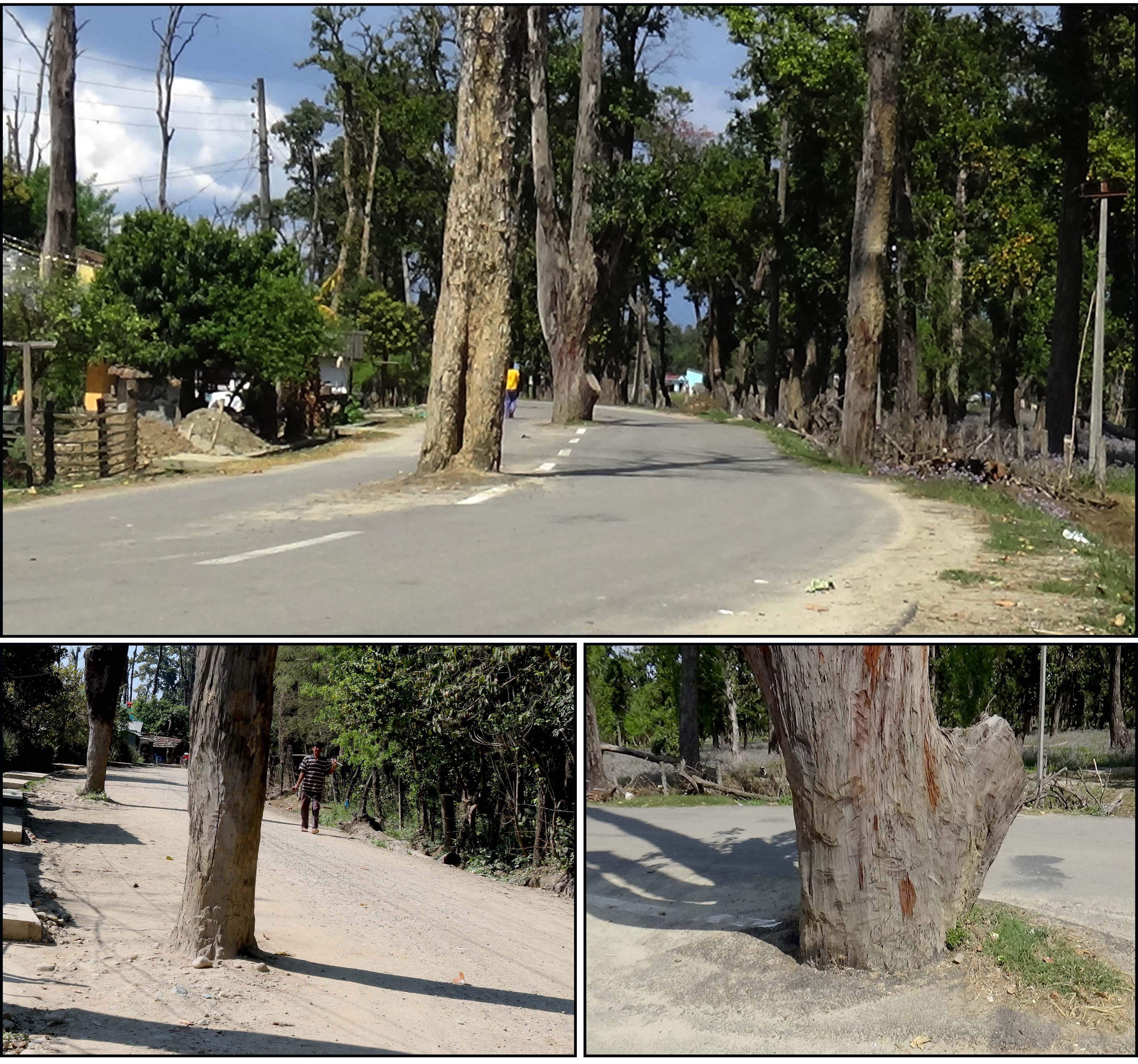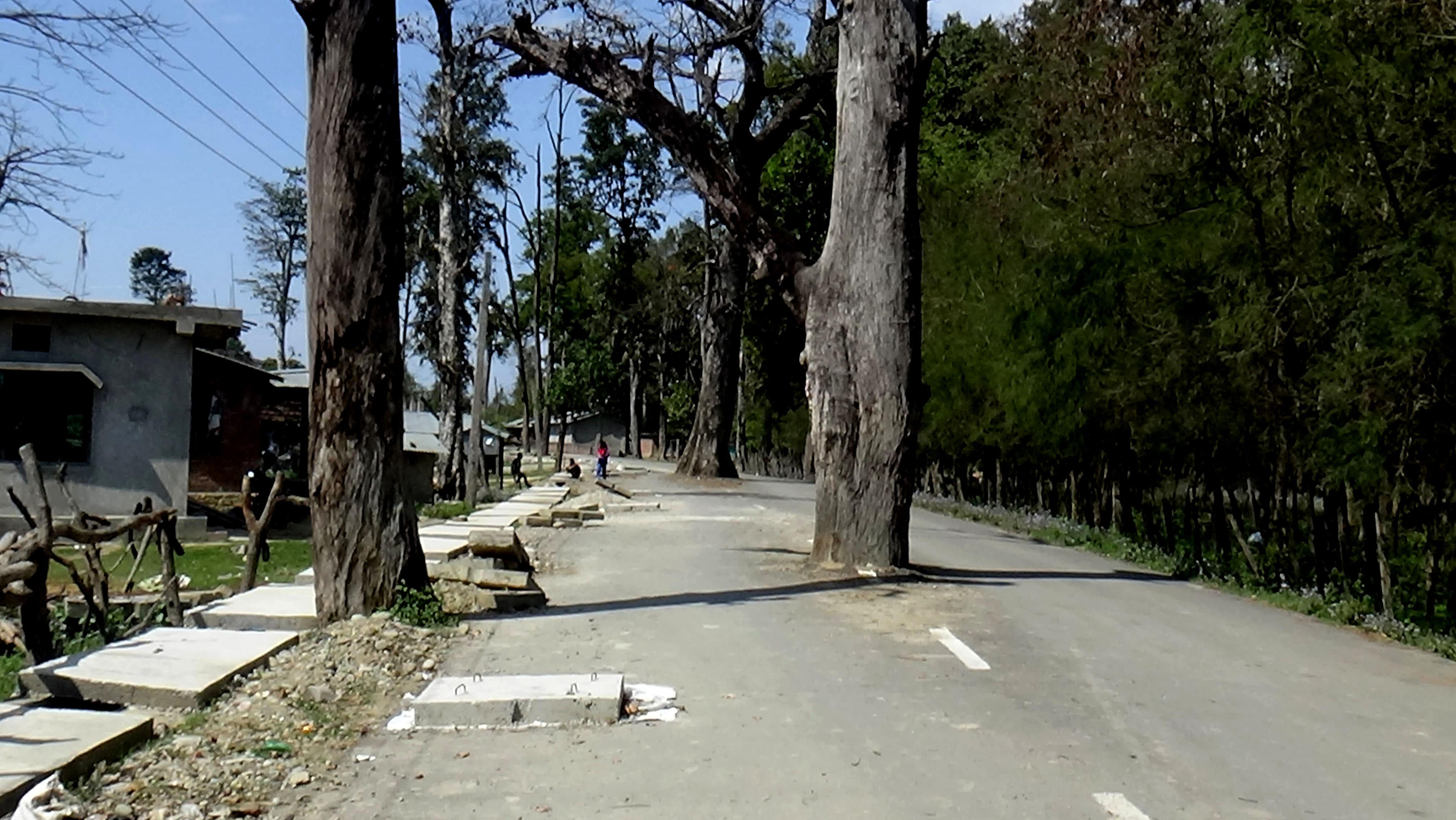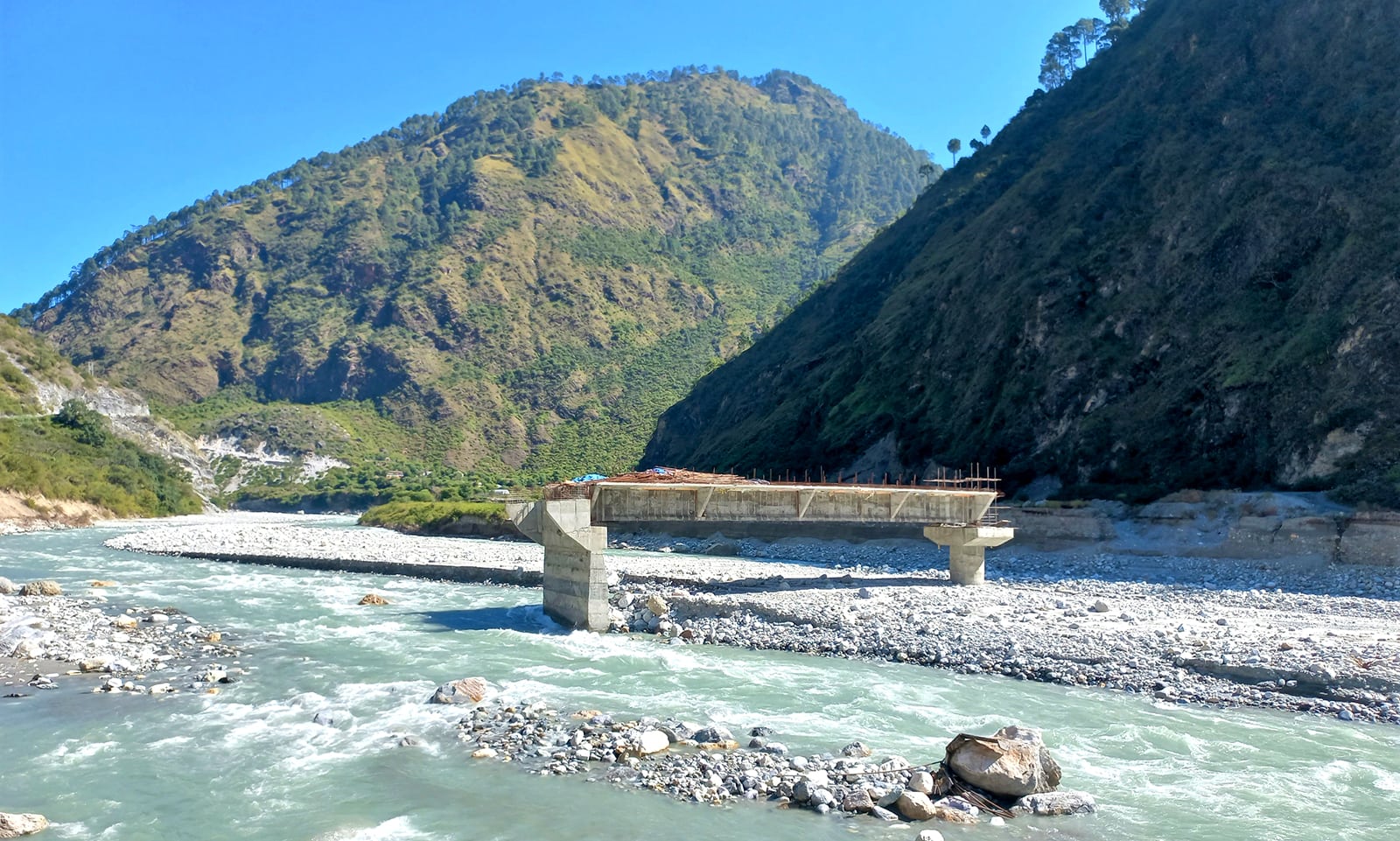Over 282 Sal trees, 204 electricity poles and two transformers dot the 50 km road sections completed in the first phase last year. The blunder persists in the second phase as government agencies pass the buck to each other.
Janak Bista: Centre for Investigative Journalism, Nepal
In February/March and March/April 2017, the Federal Project Implementation Unit (FPIU), Kailali, under the Department of Urban Development and Building Construction (DUDBC), invited bids, in five separate packages, for blacktopping various road sections totaling 50 km within Dhangadi Sub-Metropolitan City. After bidding, the contracts for the construction work was awarded to two local contractors, Royal JV and KS JV. The former is operated by Prakash Sethi, former president of the Contractors’ Association of Kailali, and the latter by Bhim Bahadur Pal, central committee member of the Federation of Contractors’ Associations of Nepal.
The contracts, costing 71 crore and 32 lakh rupees, were signed between the Ministry of Urban Development (MoUD) and the contractors on June 23, 2017. The contractors handed the blacktopped road sections over to the authorities as per schedule on July 15, 2019.

Shoddily blacktopped Kalika Mandir Road in Dhandagi Sub-metropolitan’s Ward-7.
The roads, however, bear testimony to a serious flouting of minimum standards during the construction work. Scores of trees and electricity poles, along with a couple of transformers, dot the roads and the adjacent gutters; the mandatory environmental impact assessment (EIA) that precedes the construction of roads remains to be passed; the assessment of the completed roads has been perfunctory at best; and the roads already show signs of wear and tear.
The FPIU, Kailali is now finally preparing to get the EIA passed, months after the completed roads had been brought into operation and even begun to wear away.
Mahendra Panta, the then chief engineer of Division Road Office, Kailali said a detailed project report (DPR) is to be done mandatorily once a road project is selected. If a section of the road falls in a forest area, the EIA is to be done mandatorily along with the DPR. “The tender process begins only after the DPR and the EIA are approved,” Panta added.
However, rather than wait for EIA to be approved, the MoUD began the first phase of the construction work claiming that a delay would ‘freeze’ the budget. And the result is for all to see: over 282 trees, 204 electricity poles and two transformers dot the 50 km road sections completed in the first phase.
Of the total 50 km road sections constructed in the first phase of the project under the Intensive Urban Development Program, three roads fall in Dhangadhi Sub-Metropolitan City’s Ward-1; two in Ward-2; one in Ward-3; one in Ward-4; two in Ward-5; one in Ward-14; two in Ward-16; one in Ward-17; two in Ward-18; and three that connect Wards 5, 6 and seven.
The 3.3-km Jaali Road that connects Kalika Temple and Campus Bridge in Ward-7 has 43 trees and seven electricity poles in the middle or on either side; the 8-km Bhansar-Rajpur Road has one tree and forty-eight poles; the 3-km Hulaki Road-Kamaiya Basti “D” Village Road has four trees and 25 poles; the Fulbari-Cold Store Road has four poles and a transformer; and the 1-km Shivanagar-Jali Road has 30 poles along the gutter.
Similarly, the 1200-metre Karbasthan Road has seven trees and nine poles; the 900-metre Baiyabehadi-Saraswatinagar Road has 26 poles (including some belonging to the Nepal Telecom); the 620-metre Aauji-Kalika Road has five poles; the 500-metre Sheetal Marg-Jyoti Boarding Road has four poles; the 2-km Peepal Chautara-Jai Matyari Bela Road has seven trees and 30 poles; and the 12-km Urja Pathari-Dharjunna Road has four trees and three poles either in the middle or on either side.
These are but a few instances of the trees and the poles being left unmoved even as the blacktopping of the roads have been completed.
Locals express dismay at the way minimum standards were done away with during the construction of these roads. “We requested the local representatives at the Sub-Metropolitan City and the officials at the DOUDBC several times. But nobody paid any heed to our requests,” Suresh Thakulla, a resident of the Dhangadhi Sub-Metropolitan City’s Ward-7, told the Centre for Investigative Journalism, Nepal (CIJ, Nepal).
The contractors, meanwhile, claim to have faced difficulties while blacktopping the roads with the trees and the poles intact. “The roller needs to press the blacktopping for the road to become durable. But we could not use the roller at many places since the trees and the poles were not removed,” said Tek Bahadur Malla, a representative of Royal JV.
Repeating past mistakes
As though the mistakes committed in the first phase of the project were not enough, the MoUD is repeating them in the second phase as well. For the second phase, the contract worth 83 crore and 43 lakh was awarded to Lama Khadka Krishna JV, a company operated by Ratna Bahadur Khadka, central vice-president of the Federation of Contractors’ Associations of Nepal, on March 12, 2018. The project, which includes 27 roads totaling 42 km is slated to be completed before March 11, 2021.

The result of conflict between two government agencies: In Ward-7 of Dhangadi Sub-metrolitan, the road constructed despite a tree in the middle. Photos: Janak Bista
In an eerie resemblance of the first phase, the trees and the poles on the roads remain intact even as the contractor has begun work on the second phase. According to Rabindra Bahadur Bohara, the then chief of the FPIU, Kailali, there are over a hundred trees along the 42-km stretch of the road being constructed in the second phase. The FPIU, Dhangadi could not provide the exact number of trees and poles dotting the roads being blacktopped in the second phase. [A petition under the right to information has been filed at the Unit. The figures in the report will be updated upon receipt of a response from the Unit].
A cursory glance at the number of the trees and the poles being left intact in a few road sections under construction is enough to expose the utter disregard of minimum standards that continues unabated as the blacktopping project enters the second phase. The over-1-km Shivapuri road in the Sub-Metropolitan City’s Ward-4 has 10 dried Sal trees and the 20 electricity poles; and the 1.8 km Jaali-Peepal Chowk to Campus Bridge Road in the Sub-Metropolitan City’s Ward-6 has seven electricity poles and 10 trees. There is no sign of the trees and the poles being removed anytime soon even as the contractors have begun preparations for blacktopping the roads.
“We’ve started blacktopping two roads in the Sub-Metropolitan City’s Wards 13 and 19. We have also already finished graveling the roads that remain obstructed by the trees and the poles,” said Deepak DC, side in-charge engineer of the contractor company, Lama Khadka Krishna JV.
Deepak Thapa, chairperson of Dhangadhi Sub-Metropolitan City’s Ward-4, said the blacktoping of the roads without removing the trees and the poles had led to several problems. He added that the Sub-Metropolitan City’s attempts to get the trees and the poles removed had failed to yield results. “We also requested the Division Forest Office several times to remove the trees on the roads, but they have turned deaf ears,” Thapa said.
Legal guidelines flouted
The problem with the project started right when the FPIU, Kailali awarded the contract for the first phase of the project, for blacktopping a total of 50 km of road sections, to the contractors even before the EIA was approved. Parikshit Kadaria, the chief engineer of the Unit, conceded that the EIA report remains to be approved even as of today. “We began work before the EIA report was approved because there was no clear legal mechanism at the time,” Kadria said. But since the Public Procurement Act, Ninth Amendment, 2076 (2019), has a clear provision, Kadaria said, the mistake committed in the first phase won’t be repeated in the second one.
However, contrary to Kadaria’s claim, the previous Environment Protection Act, 2053 (1997) itself makes EIA mandatory for executing any development project. Similarly, Article 3 of Section 2 the Environment Protection Rules, 2054 (1997) makes preliminary environmental tests and EIA mandatory for construction of roads according to their types. While Appendix 1 of the Rules makes preliminary environmental tests mandatory for building district level and urban roads, Appendix 2 makes EIA mandatory for building national highways and major arterial roads.
Article 3 of the Environment Protection Act, 2076 (2019) makes EIA mandatory for construction of roads. Article 3’A’ of the Act makes submission of the EIA to the designated agency for any kind of project designated by the government mandatory. It is only after the EIA thus submitted gets approved that the project can be taken forward.
But these provisions have been summarily bypassed while blacktopping the roads in Dhangadhi.
Kadaria, the chief engineer at the FPIU, Kailali conceded that the mandatory provisions of getting the EIA and the DPA conducted had been done away with for lack of time. “We were afraid it would take time to get the EIA approved and the trees and the poles removed. So we just blacktopped the roads hurriedly due to fears of a budget freeze,” Kadaria said.
Similarly, Rabindra Bohara, the then chief at the FPIU, Kailali, said the contract was awarded even before the EIA was approved because of the complicated process. “The EIA was not approved due to various reasons. Things became difficult because the process of cutting the trees is long and complicated even after the EIA is approved,” Bohara said.
What’s more, government agencies contradict each other in the case of the blacktopping project. The Division Forest Office (DFO), Dhangadhi blames the DUDBC for building the road illegally. Ram Chandra Kandel, chief forest officer at the DFO, Dhangadhi said DUDBC had constructed the road in the forest area without so much as seeking the right of possession. “The Department has not done any coordination with the DFO while constructing the roads,” Kandel said.
As per Article 68 of the Forest Act, 2049 (1993) no road can be constructed in a forest area without obtaining permission from the DFO. If the construction of a road is absolutely necessary, the DFO can recover equivalent cash or land which could then be used for compensatory afforestation. But the provision has been bypassed in the case of the roads being constructed in forest areas in Dhangadhi.
As per the law, the right of possession of a forest area can only be provided by the decision of the federal cabinet. However, in Dhangadhi, the MoUD has already constructed 50-km of road sections without obtaining the right of possession, and is in the process of constructing another 42 km similarly. “The Intensive Urban Development Program has constructed the road illegally. We can’t give permission for removal of the trees on the road now,” Kandel, the chief forest officer at DFO, Kailali, told CIJ, Nepal.
Shoddy work, flimsy roads
The shoddiness of construction work is evident in the way the roads completed in July 2019 have already started to wear away. The Bhansar-Rajpur Road that was blacktopped hurriedly last year has been damaged at many points. Bal Bahadur Aer, chairperson of Dhangadhi Sub-Metropolitan City’s Ward-3, expressed dismay at the dismal condition of the road section. “The road got damaged just six months after it was constructed. There are trees and poles in the middle of the road. The road has become a total farce.”
The Urma-Dhurjanna Road in the Sub-Metropolitan City’s Ward-17 also has signs of wear and tear. The contractor, though, is quick to put the blame on others rather than the quality of its work. KS JV operator Surendra Pal claimed that the roads had been damaged by vehicles heavier than 10 tons plying them whereas they are meant for vehicles lighter than 10 tons. “There’s no doubt that the roads have been damaged. But we’ve started repairing them,” Pal added.
The condition of the completed roads is so bad that some of the road sections such as Fulbari-Campus Road, Karbasthan Road, Kalika Tole-Auji Tole Road, and Peepal Chautara-Jaoi Matyari Road have grass grown on them. Kailash Nepali, a local, said this was proof enough that the roads had been constructed shoddily. “Grass has grown on the blacktopped road. This clearly shows that the minimum standard was bypassed during construction,” he said.
The Dhangadhi Sub-Metropolitan City acts as a coordinating agency for implementation of the Intensive Urban Development Program. A monitoring committee has been constituted under the coordination of Nirpa Bahadur Oad, the Sub-Metropolitan City’s mayor. However, rather than monitoring the construction of the roads, the committee passes the buck of accountability on the Division Forest Office.
For those in the know, though, there is a different ‘inside’ story to the entire row. The big three contractors that were awarded the contracts are known to have close links with Oad, the mayor. Prakash Sethi, former president of the Contractors’ Association of Kailali, Ratna Bahadur Khadka, central vice-president of the Federation of Contractors’ Associations of Nepal, and Bhim Bahadur Pal, central member of the Federation of Contractors’ Associations of Nepal, are all close to the mayor. This has resulted in the local representatives being apprehensive about questioning the shoddy construction work done by the contractors. Oad himself is known to be in a Catch-22 situation, unable to object strongly to the substandard work done by the contractors close to him.
Mayor Oad, however, denies these claims. “There are 384 trees in the middle and on either side of the roads. The EIA was not conducted, for sure, because the process was complicated,” Oad said. He further claimed that he had written to the Division Forest Office to immediately remove at least 92 trees from the middle of the road after several of his attempts failed. “I even approached the cabinet with a request to get the trees and the poles removed but in vain,” Oad said.
Lockdown halts work
The nation-wide lockdown announced by the Government of Nepal from March 24, 2020 to control the spread of Coronavirus (Covid-19) has halted the work on the remaining 42 km stretch of the road. The contractor, Lama Khadka Krishna JV, says it has retained its workers in Dhangadhi for the past month-and-a-half hoping to begin the work soon. “We’ve been taking care of the workers with the hope that we can begin work as soon as the lockdown is lifted,” said Deepak DC, an engineer working at the company.
Meanwhile, the contractor has requested the District Administration Office, Kailali for permission to begin construction work immediately.
“The construction work has been halted due to the lockdown. So we have requested the administration for permission so that we can resume the construction work,” Parikshit Kadaria, chief of the FPIU, Kailali, told CIJ, Nepal.



